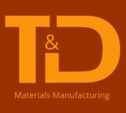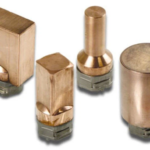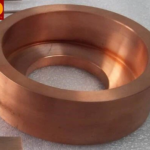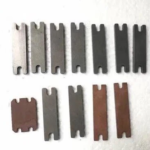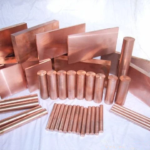Tungsten Copper Alloy
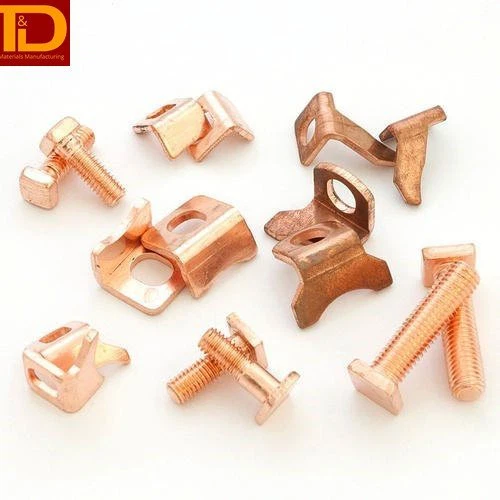
Physical Properties
- Density: 16.75 – 18.25 g/cm³
- Melting Point: Between 3000°C and 3410°C (tungsten melting point), though the alloy does not have a single melting point but rather a melting range.
- Thermal Conductivity: 180 – 210 W/m·K
- Electrical Conductivity: 30 – 50% IACS (International Annealed Copper Standard)
- Hardness: 150 – 250 HB (Brinell Hardness)
Chemical Properties
- Oxidation Resistance: Improved compared to pure copper, but tungsten’s oxidation resistance enhances the overall property.
- Corrosion Resistance: Good resistance to corrosion in most environments; however, copper content can lead to susceptibility in certain corrosive environments.
- Reactivity: Generally stable; copper can oxidize at high temperatures, but tungsten remains inert.
Overview
Tungsten copper alloy, commonly referred to as W-Cu, is a composite material consisting of a mixture of tungsten and copper. This alloy combines the high melting point and strength of tungsten with the excellent electrical and thermal conductivity of copper. Typically, the alloy contains between 70% and 90% tungsten by weight, with the balance being copper. The production of tungsten copper alloys involves powder metallurgy techniques, where tungsten and copper powders are mixed, compacted, and sintered.
Uses of Tantalum
Tungsten copper alloys are widely used in applications that require a combination of high thermal and electrical conductivity, high melting point, and good mechanical properties.
Electrical & Electronic Applications
- Electrical Contacts: Used in circuit breakers, electrical switches, and relays due to their excellent conductivity and resistance to arc erosion.
- Heat Sinks: Employed in electronic devices to manage and dissipate heat, taking advantage of the high thermal conductivity of copper and the thermal stability of tungsten.
- Electrodes: Used in electrical discharge machining (EDM) and resistance welding for their strength and conductive properties.
Thermal Management
- Heat Spreaders: Utilized in microelectronics and high-power laser systems to spread and dissipate heat efficiently.
- Cooling Devices: Used in devices requiring efficient heat removal, such as radiators and cooling systems in aerospace and automotive industries.
Aerospace & Defense
- High-Temperature Components: Used in rocket nozzles and other aerospace components that must withstand extreme temperatures and thermal cycling.
- Radiation Shielding: Offers effective radiation shielding for aerospace and defense applications, benefiting from tungsten’s high density.
Industrial Applications
- Machinery and Equipment: Used in parts that require high wear resistance and thermal stability, such as dies and molds in manufacturing processes.
- Plasma Arc Welding: Used in plasma arc welding electrodes, benefiting from the high-temperature resistance of tungsten.
Advantages & Disadvantages of Tungsten Copper Alloy
Advantages
- High Thermal Conductivity: Excellent for thermal management applications.
- High Electrical Conductivity: Suitable for electrical contacts and electrodes.
- High Melting Point: Can withstand high temperatures, making it suitable for high-temperature applications.
- Good Machinability: Easier to machine compared to pure tungsten.
Disadvantages
- Cost: More expensive than some other materials due to the cost of tungsten.
- Density: High density can be a drawback in applications where weight is a concern.
- Corrosion: Copper content can be susceptible to corrosion in certain environments.
Physical & Chemical Properties of Tungsten Copper Alloy
| Property | Value |
|---|---|
| Density | 16.75 – 18.25 g/cm³ |
| Melting Point | 3000°C – 3410°C |
| Thermal Conductivity | 180 – 210 W/m·K |
| Electrical Conductivity | 30 – 50% IACS |
| Hardness | 150 – 250 HB |
| Oxidation Resistance | Good |
| Corrosion Resistance | Good |
Major Applications of Tungsten Copper Alloy
| Application Area | Examples |
|---|---|
| Electrical and Electronic | Electrical contacts, heat sinks, electrodes |
| Thermal Management | Heat spreaders, cooling devices |
| Aerospace and Defense | High-temperature components, radiation shielding |
| Industrial | Machinery parts, plasma arc welding electrodes |
Tungsten copper alloy is an essential material for applications that demand a combination of high thermal and electrical conductivity, excellent mechanical properties, and the ability to withstand extreme temperatures. Its use in electrical and electronic applications, such as electrical contacts, heat sinks, and electrodes, showcases its exceptional performance in environments where efficient thermal and electrical management is crucial. The aerospace and defense industries benefit from the alloy’s high-temperature stability and radiation shielding capabilities. Industrial applications leverage its durability and machinability for manufacturing high-wear components. Despite its higher cost and density, the unique properties of tungsten copper alloy ensure its continued demand and utilization in advanced technological and industrial fields.
